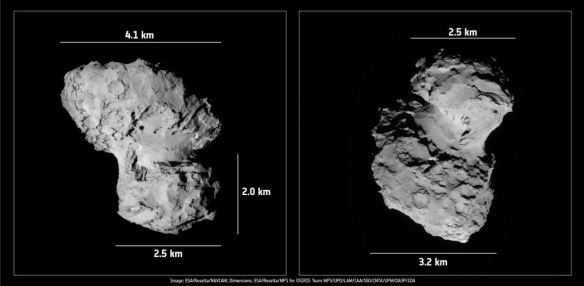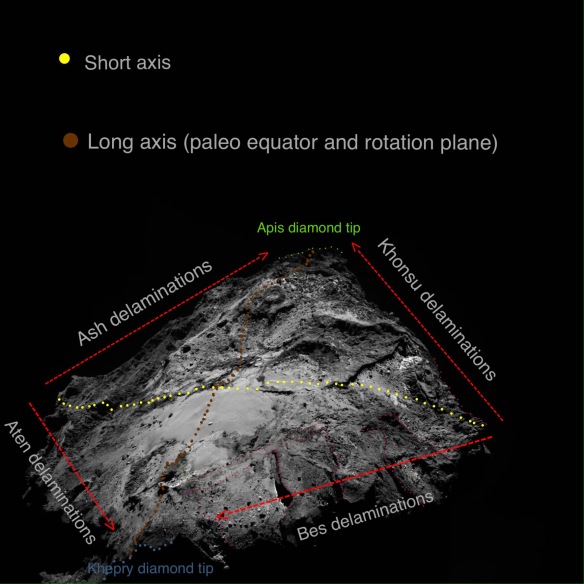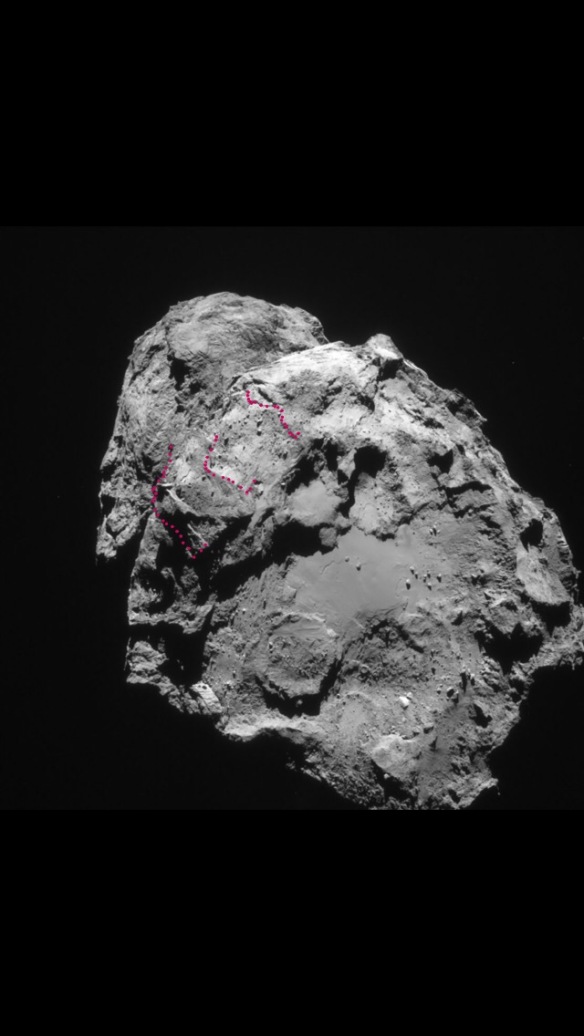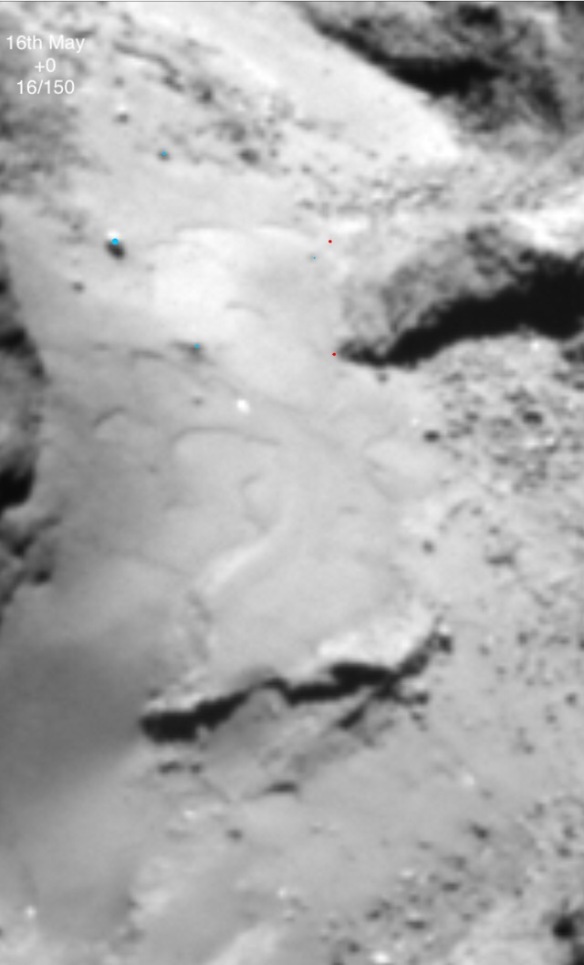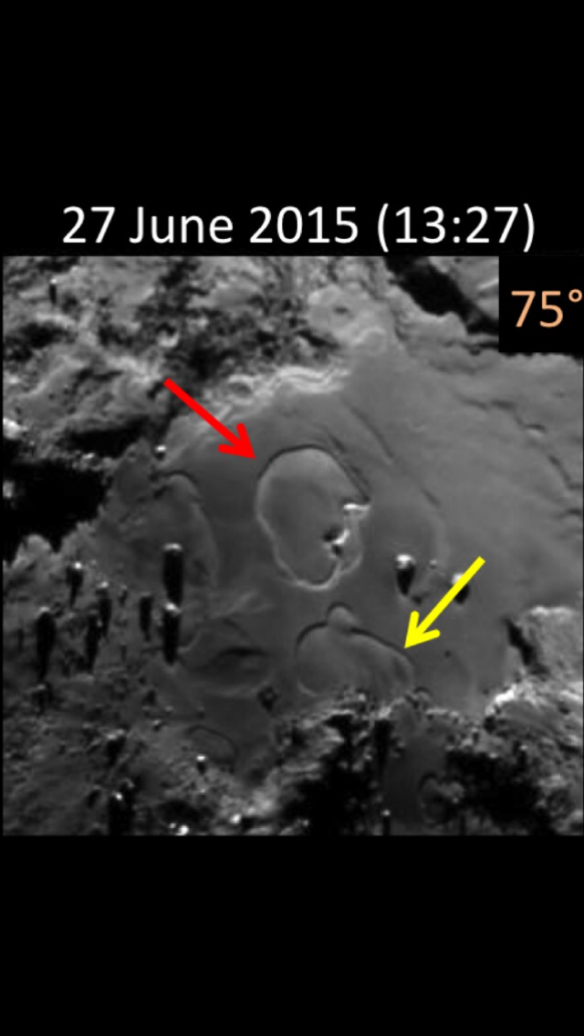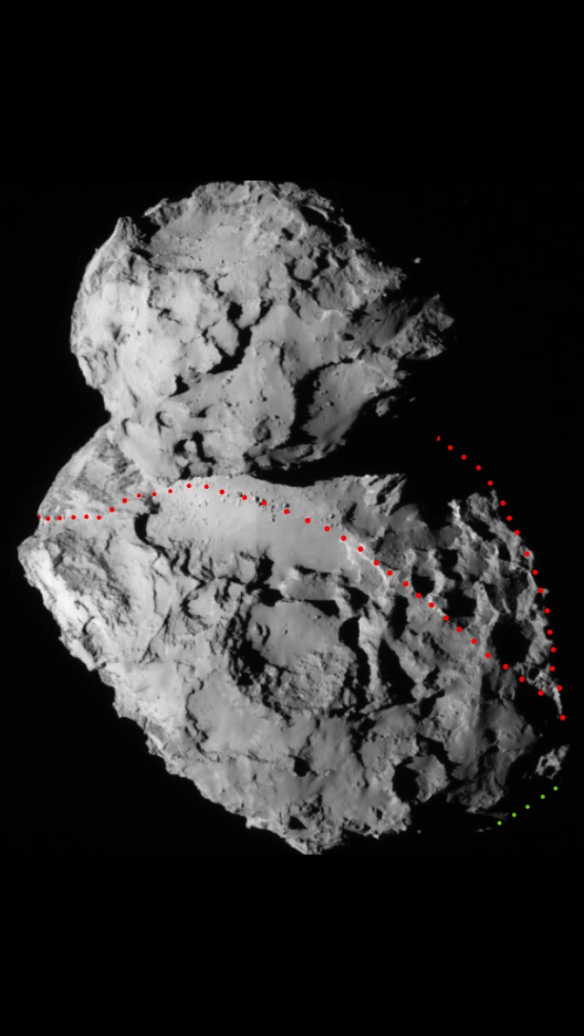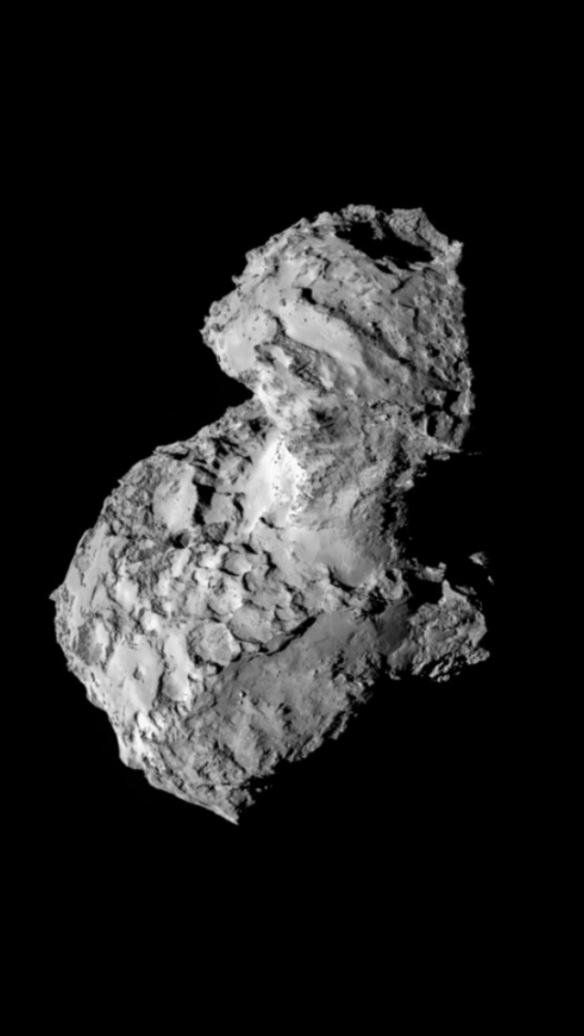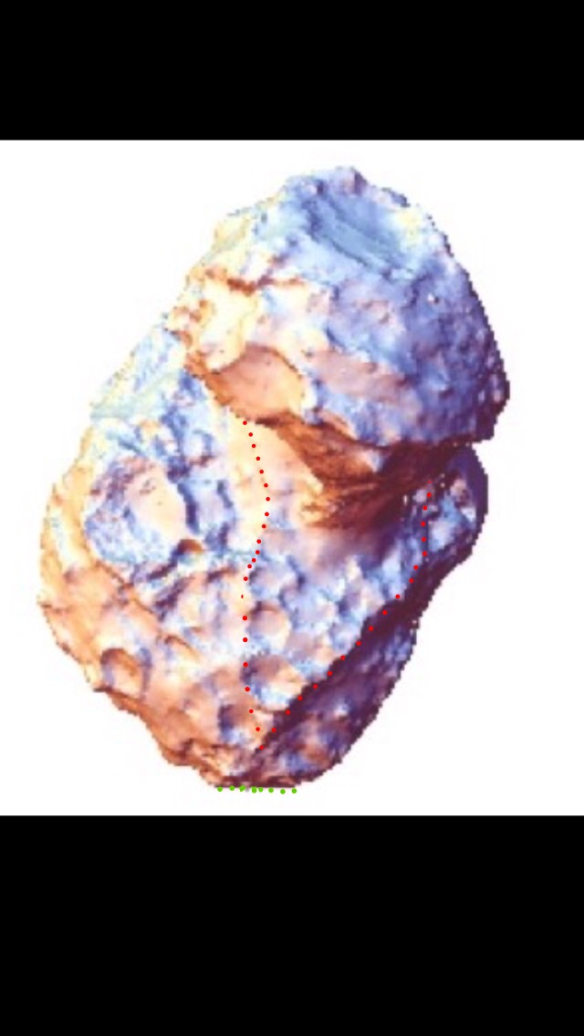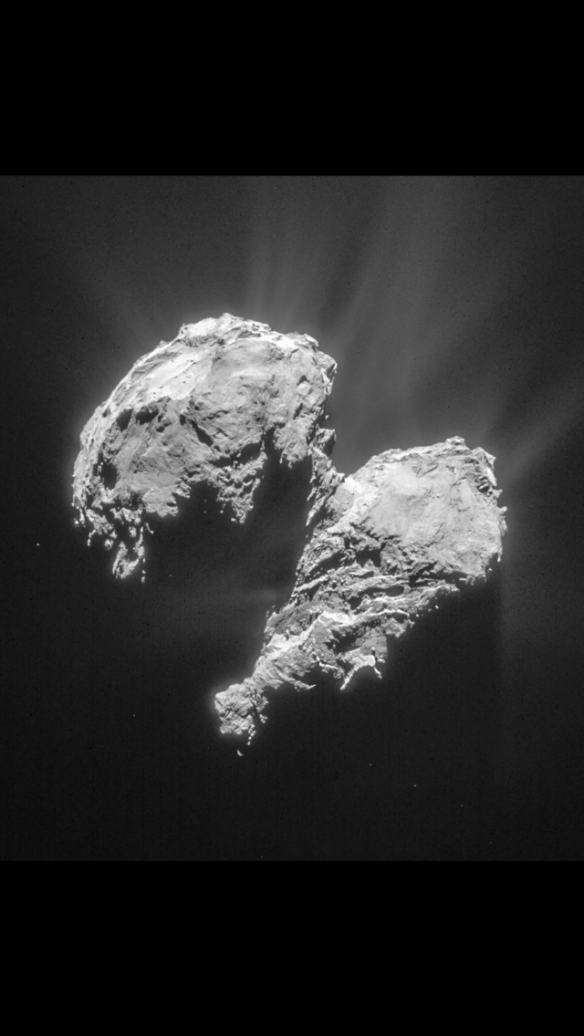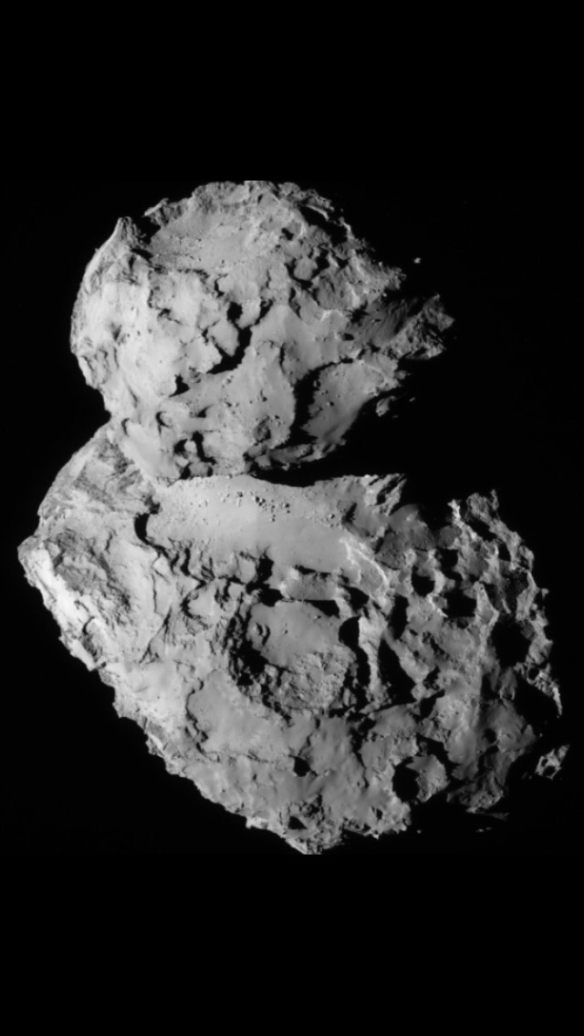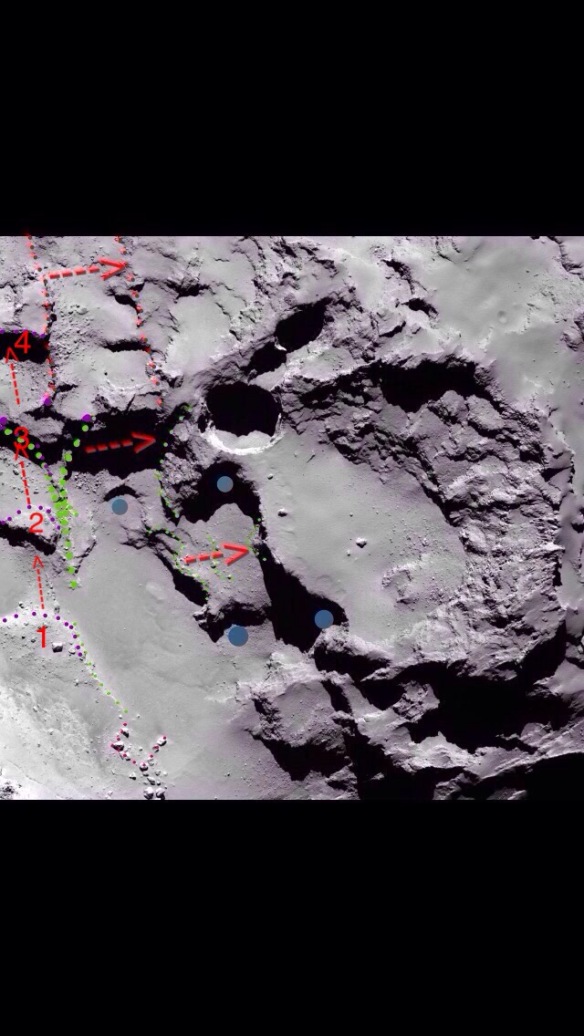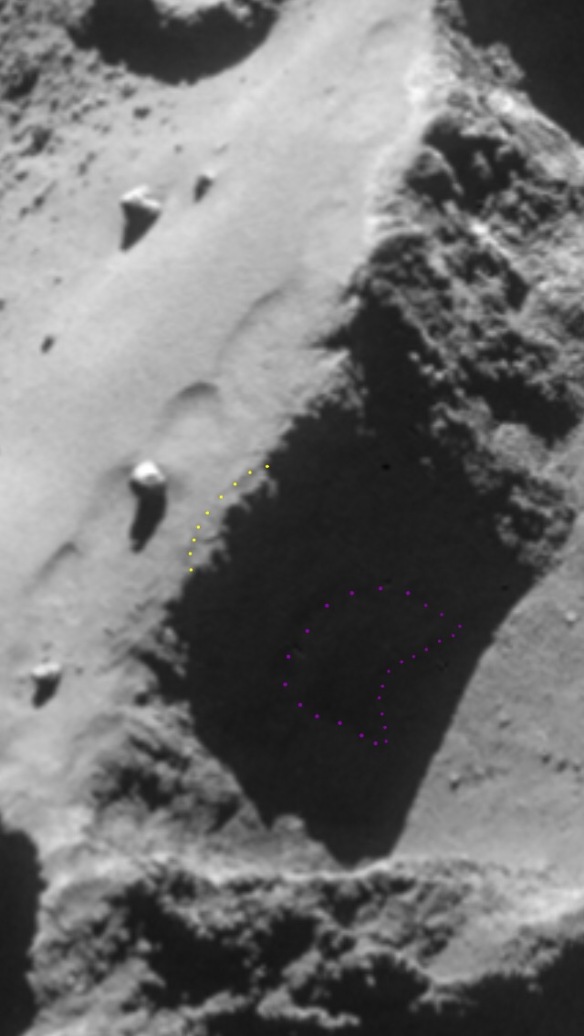
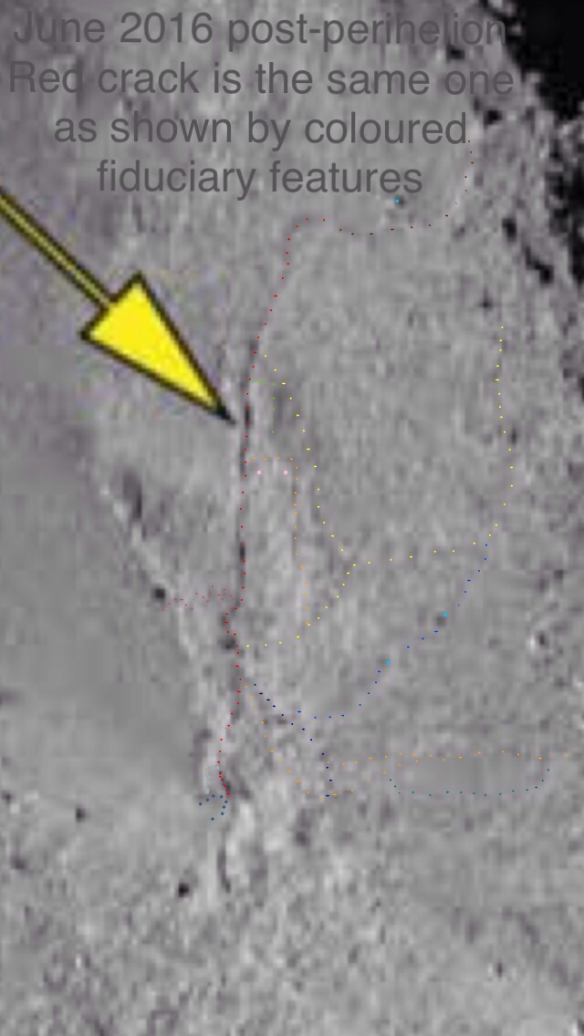
Photo credits listed below.
UPDATE 12th April 2017
The lead author of the paper, M. R. El-Maarry, kindly responded to my email notifying him of this post. He gave permission to attach his reply here so I’ve put it at the top as I did for other similar lead author responses. The original post starts after “///END”
Dear Andrew,
Thank you for your email. I have have gone through your blog and I am as always impressed with the amount of effort you put into your analysis.
With regards to the second fracture in the neck you refer to, I remain skeptical about your results, as well as mine. I have INDEED taken account of geometry and illumination conditions when looking at all the changes in this study. Even after looking at your thoughtful analysis, I am still not convinced that the fracture was pre-existent.
My geologic interpretation (and i say “interpretation” because this means you can certainly have another interpretation) remains that this fracture indeed formed or grew in size after perihelion.
I am not sure if you have the paper or not, or are just relying on the figures but I did EXPLICITLY say in the paper’s main text that this was a “possible development of new fractures….” because despite my conclusion, I wanted to leave the door open for further analysis/scrutiny from me or others (if you have the paper, please check the main text, otherwise I can send it to you). It is unfortunate from my side that this is not conveyed in the figure caption as well, nor was it expanded upon in the supplementary material. I have no problem accepting the validity of your interpretation, even if it doesn’t match mine.
Therefore, I do not consider this an “error” (nor would the journal consider it as such I believe) and I would encourage you to submit your findings, and I can promise you that if I got the paper as a reviewer I would never reject your analysis because it contradicts mine. I believe this is how science should progress so publish your (excellent) work and let the community decide : )
Apart from that, It looks from your blog that you have not read the paper’s supplementary material so please if you do not have access to the journal , just let me know and I can send you a copy. There we have reported on the movement of the small boulder close the larger crack, which you show in the blog. I have also indeed noticed the changes in the first crack (the subsidence you refer to) but in the end I chose to highlight a few key changes in this paper. It is not meant to be a catalogue of ALL changes. Similarly, I also agree with you about the cliff collapse in the south but again the only reason for not including it was to highlight two other clearer examples, that’s all. In the end, there are bound to have been more changes in the south than the north, but we did not achieve the same resolution in the south pre-perihelion to carry a similarly detailed analysis. All we can say is that NO MAJOR changes to the landscape occurred (no creation of new large units, no significant changes to regional boundaries, no new large depressions such as Aten, etc), and that is the key result of the paper.
Finally, also in response to a comment you made in your blog, you mention that the June 2016 image is still not released; this is true for the database as a whole but ALL the images used in this study are indeed available for download. You should find the url link in the science paper acknowledgements. This is a Science journal policy so you have access to the study database if you need.
Please feel free to attach my response in your blog if you want.
Best regards to you and Marco,
Ramy
///END
ORIGINAL POST
The top two headers are from figure 1B of the paper in the title and have added coloured dots. The dotted lines show identical fiduciary features. The crack is red and is the same crack in both photos. The big yellow arrow is original. The third photo has most but not all of the same fiduciary features. Full zoom and much patience is required for all photos in this post. 




Copyright for headers (photos 1 to 5):
Photos 1 and 3: ESA/Rosetta/MPS for OSIRIS Team MPS/UPD/LAM/IAA/SSO/INTA/UPM/DASP/IDA/A.COOPER
Photos 2, 4 and 5: Copyright: ESA/Rosetta/MPS for OSIRIS Team MPS/UPD/LAM/IAA/SSO/INTA/UPM/DASP/IDA/ M. R. El-Maarry et al. (2017)/ A.COOPER
Here are the first three headers reproduced with their originals for toggling between annotated and unannotated versions. 

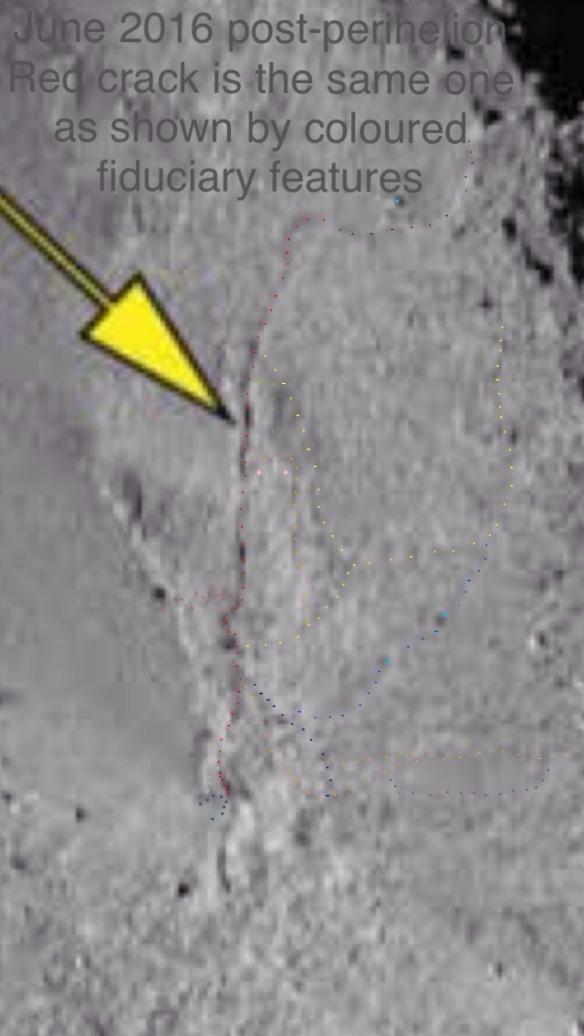



INTRODUCTION
A 67P morphology paper by the Rosetta OSIRIS team was recently published in Science Magazine. It’s entitled ‘Surface changes on comet 67P/Churyumov-Gerasimenko suggest a more active past’. It’s by M. R. El-Maarry et al. and was published on 31st March 2017. Here’s the link (paywalled).
http://science.sciencemag.org/content/355/6332/1392.long
In figure 1B of the paper, two images of the neck in the Anuket region are compared. One is pre-perihelion, dated August 2014. The other one is post-perihelion and dated June 2016. This figure will be referred to a lot in this post. To be clear, stretch blog figures are photos with photo numbers and never called figures so figure 1B always refers to this figure in the paper in question.
The authors state that a new crack has developed on the neck over perihelion because it appears to be evident only in the post-perihelion photo in figure 1B. However, it’s evident in the pre-perihelion photo as well and so it’s not a new crack.
Both images in figure 1B are OSIRIS Narrow Angle Camera (NAC) images. The abbreviation, NAC, is used from here onwards.
The caption for figure 1B states, “Extension of a preexisting fracture in the neck region and the development of a new one next to it.”
So this post is about the new crack which is to the left of the preexisting crack in figure 1B or below it if viewed in ‘upright duck’ mode with the head lobe above the body lobe and the neck vertical between them. In figure 1B, the head is to the right and body to the left with the neck going left to right.
Some other photos in this post are in upright duck mode and so ‘vertical’ and ‘horizontal’ are used with respect to that orientation unless otherwise stated.
The crack extension claim is also looked at briefly at the end.
The penultimate sub-heading shows that this analysis of the supposed new crack is not new research nor some sort of learning curve adding to the sum of knowledge on the stretch blog. This (preexisting) crack is just one small part of what is a completely grokked area of the neck, much of it already blogged. This is why I could see the problem immediately on seeing the post-perihelion photo claiming the crack was new.
Stretch theory advocate, Marco Parigi is mentioned a lot in this post. However, as is the case with all posts on his blog and mine, it’s not a joint post. Opinions are my own and he was notified on publishing.
The lead author has been notified of this blog post via the contact email in the paper. I expressed my regret that he’s in the firing line since I very much respect the fact he engaged with me and Marco Parigi in such a cordial and constructive manner on another issue regarding another paper. My concern isn’t about any individual lead author on any one paper because there are always 50 or more OSIRIS co-authors. The issue is the culture in the OSIRIS camp with respect to the application of rigour in their work and the way it affects their output. The other issue is the quality of peer review at Science Magazine.
IF YOU HAPPEN TO BE AN OSIRIS AUTHOR…
If you’re an OSIRIS author and you decide a quarter of the way in to this post that it’s overly detailed, repetitive and frankly, tedious, it will betray a lot about the difference between the way OSIRIS papers present the cometary features and the way Marco Parigi and I have been presenting them in blog posts for the past two-and-a-half years.
If you find it a strain to have to zoom in so far before you see any photo annotations and then have to keep zooming right out again to get any idea of where you’ve tracked along to, you’ll have an idea of how we’ve been looking at the morphology all this time.
The reason this post is so detailed is that it’s presenting features at the 5- to 10-metre scale. This means that along any given crack or cliff line there’s five times more to talk about than if we stick to a 25- to 50-metre scale, which seems to be the lower scale at which OSIRIS papers routinely analyse cracks, cuestas, cliffs and pits. (Philae data is higher resolution by definition and most boulders and icy patches are small-scale).
The supposed new crack in the paper is a case in point regarding the favoured larger scale analysis. It’s about 150 metres long and it’s presented as a fait accompli in a single grainy photo with no double-checking from different angles or analysing it along its length at the 5- to 10-metre scale. If the authors had done this, it wouldn’t have been misidentified as a new crack.
The original, non-compressed, higher-res NAC photo is presumably listed in the supplementary pages but they are paywalled and besides, it’s a June 2016 photo. NAC photos are still under embargo from May 24th 2015 onwards as of the publication of this post.
Presumably no one, including peer reviewers, accesses the supplementary pages anyway because that’s where I’ve found glaring mistakes in two other papers (of seven papers all-told). If the peer reviewers do access them, they clearly don’t know the comet’s morphology or 1-year-old literature on recent changes. If they did, they wouldn’t have let these papers through.
Coupled to the detailed, finer-scale description, if I don’t keep the reader on track as to exactly where we are along the crack and they misinterpret where I am then they’ll go off along another crack and never understand what I’m presenting. This is the case even for Marco Parigi who knows the Anuket neck still better than I do. We both know every nook and cranny but if I don’t explain the exact location of a particular 5 x 5 metre or 10 x 10 metre feature carefully at each stage then even he will go off down another path. This is why it’s so detailed and repetitive. It’s a completely different approach from the easy task of presenting obvious larger scale features which haven’t undergone these rigorous, small-scale checks.
As well as the high-res analysis, we have to bear in mind factors such as the viewing angle between different photos, lighting and shadows, overexposure of certain areas, parallax/foreshortening, pixel size and JPEG anomalies. All these things can make an unchanged area appear completely different from pre-perihelion to post-perihelion and indeed this has happened in the case of the supposed new crack.
As if this isn’t enough, features on the comet are generally amorphous in shape, similar at all scales, the same colour and apparently changing their (amorphous) shape between photos.
The distance vector relationship between these features then has to be described within a framework of six degrees of translational freedom and six of rotational freedom. All of this can of course trip the reader up as well. So please blame the comet and not the stretch blog for the need for careful and detailed description.
Finally, why would anyone expend half a career, vast sums of money, sleepless nights and sweat and tears to decipher the birth of the solar system only to say at the end of it all “please spare me the detail”? And especially if that detail is the only method that arrives at right answers?
THE CONFOUNDING ISSUES
There are several confounding issues that might have led to the spurious identification of a new crack but the authors should have been aware of these and proceeded with caution. Careful scrutiny of the two photos in their figure 1B, by using multiple fiduciary points in both, shows the crack tracking along in both. It tracks with the same relationship to the fiduciary points in both cases. This is shown in the first two header photos.
Incidentally, the pre-perihelion version is the original, uncompressed, hi-res version taken from the archives as opposed to the lower res version in figure 1B. As mentioned above, the hi-res version of the post-perihelion photo isn’t yet available to the public.
The confounding issues that might have led to the error are numbered 1 to 3, below.
1- THE POST-PERIHELION PHOTO’S VIEWPOINT IS FROM A POSITION THAT’S CLOSER TO THE ANUKET NECK
This means that the area where the crack is situated gets foreshortened because the viewing line is looking somewhat down the length of the neck in both cases.
There’s an overhang above the first section of the crack. This is where the crack tracks its way up from the flat, dusty area at the neck base. This overhang is crucial to locating the crack in both photos but it moves, via parallax between the two photos because of the extra foreshortening in the post-perihelion photo. Furthermore, it gets almost whited out (see point 3, below) which renders it almost invisible. The reason it’s crucial for locating the crack is laid out further down.
Photos 6 and 7 (including unannotated originals for toggling)- the side view showing the overhang and the massif below it. Photo 6 is dated 26th November 2014 and photo 7 is dated 28th March 2015. The purpose of these photos is to show the overhang, massif and crack from two sideways viewpoints but the dates provide additional proof that the crack is not new. 


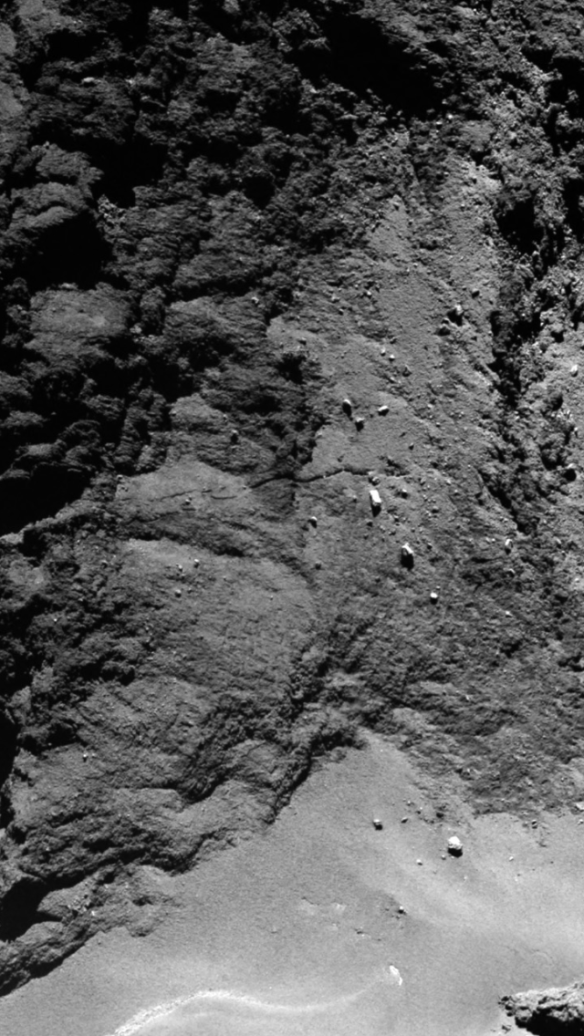
Copyright: ESA/Rosetta/MPS for OSIRIS Team MPS/UPD/LAM/IAA/SSO/INTA/UPM/DASP/IDA/A.COOPER
Key for both photos:
(If you’ve just scrolled past without toggling and just relying on dots, you’re destined not to see what 67P is trying to tell us. This process is not amenable to an impatient disposition. It requires slowing right down and tapping into a high-attention-span mode).
Yellow- the overhang and the perimeter of the massif below it at the foot of the neck. The two lines are about the same length and parallel, one above the other in these two ‘upright duck’ views. The overhang is annotated orange in the header, as part of a longer orange line. The massif perimeter is also designated orange in other blog parts. This is because they have both been traditionally coloured orange on this blog for the last two years so regular readers will make that link. They’re coloured yellow here simply because yellow shows up better when depicting their parallel nature.
Red- the crack in question, which is not new.
The overhang has a wide gap of 30-50 metres below it, to the massif below. However, the squared-off tip of the overhang droops somewhat so as to touch the massif, but the general impression is of an overhang with this parallel, 30- to 50-metre gap along most of its length.
The yellow profile of the lower massif is the profile you see when looking down on it as viewed in the two figure 1B photos. You can see from the March 28th 2015 version that although the yellow massif line doesn’t quite kiss the dust below it (except at its tip), it is directly above the true cliff base that does kiss the dust. Thus, when viewed from above as we view it in figure 1B this yellow line is, essentially, the line of the cliff base kissing the dust of the Hapi region.
Note that the massif’s yellow line runs parallel to the overhang’s yellow line when viewed both from above in figure 1B and from the side as in photos 6 and 7. This shows that one line is a pure translation from the other without any rotation introduced, meaning that you could slide the two lines back together through space on a single slide vector and they would merge without having to rotate one at the last minute to fit the other. This fact should be borne in mind as we watch them move in relation to each other, via parallax, between the pre-perihelion and post-perihelion photos in figure 1B. Since their distance vector relationship is a single, pure translation without any rotation element, any amount of relative movement via parallax will nevertheless leave them parallel, as before. Therefore, they can move closer together or further apart or slide past each other in either direction, up-frame or down-frame as we perform the parallax operation. But they will never end up at an angle to each other at the end of the process. Of course, they don’t physically move between the photos. It’s simply an apparent movement in relation to each other brought about via parallax which is, in turn, brought about by a movement of the viewpoint. However, this idea of always staying parallel helps us understand their apparent movement better. We’ll see that out of the options above, they move closer as well as sliding past each other between the two photos, all the while remaining parallel
In the pre-perihelion photo of figure 1B the overhang profile and neck base profile are so satisfyingly parallel that it looks as if the overhang should nest down onto the neck base. Part 25, published two years ago, shows that it once did so, being part of the “orange tell-tale line” linking the orange head match to the orange body match. This is another part which, along with Part 24, analyses Anuket in the most exquisite detail to reveal clear links between four head/body matches. OSIRIS will never see this at the resolution they’re working at.
When the viewpoint in figure 1B swings over towards the neck in the post-perihelion photo, the two parallel, yellow profiles move closer to each other. Although the two lines don’t actually touch, the cliff and massif they represent appear to merge. The overhang therefore appears to blend with the massif that’s 50 metres below it. This effect is enhanced by the white-out (overexposure).
Photo 8 (plus unannotated version for toggling)- the overhang and massif move closer together in the post-perihelion photo due to parallax. They appear to merge and thus the whole area appears to be smoothed over. Arrows are original to the paper.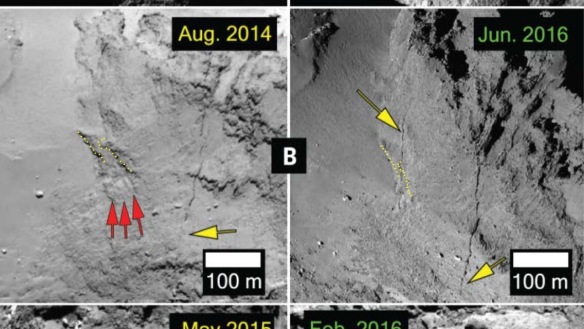

Copyright: ESA/Rosetta/MPS for OSIRIS Team MPS/UPD/LAM/IAA/SSO/INTA/UPM/DASP/IDA/M. R. EL-MAARRY ET AL.(2017)/A.COOPER
The overall effect makes the whole lower part of the neck appear as one smooth rock face in the post-perihelion photo apart from some gentle undulations and the supposed new crack. This sets us up for thinking that we’re looking at an area that’s slightly further up the neck, above both the massif and the overhang (that is, ‘above’ in upright duck mode or to the right in both figure 1B photos). This higher-up area really is a relatively smooth area in the pre-perihelion photo. If a crack really did appear here, post-perihelion, it would genuinely be new. But if it seemed to appear in this area but was actually in the misleadingly smoothed overhang area, it would be mistaken as a new crack when really it’s just the old one that’s now received some favourable shadowing by virtue of the lighting from the left.
This is what really happened. The supposed new crack is really just the same old pre-perihelion crack sitting in the same place but with its surroundings smoothed over by various chance photographic effects.
In photo 8, the two yellow lines are placed to within a lateral accuracy of 3-5 metres i.e. in terms of following the correct line. This is judged via being about one yellow dot width or 1/30th of the 100-metre length of the straight section of cliff base nearby. However, the lengths of the two yellow lines are accurate only to about 5-10 metres due to white-out versus shadowing appearing to shorten or lengthen the lines in relation to the differently shadowed photos 6 and 7. This deviation can be quantified somewhat by very careful comparison with small-scale fiduciary features in photos 6 and 7. Although this is possible, it’s beyond the scope of this post because the main point here is that the two lines move closer together. Their exact length is less important.
The apparent disappearance of the overhang should have been questioned by the authors of the paper. As mentioned above, the smoothness of the neck profile in the vicinity of the crack (post-perihelion) might imply that the overhang was lower down, perhaps hidden by a smooth bump further up. This would mean the crack was higher and therefore a new one. But the overhang isn’t hidden and it betrays the crack as being the same feature as the pre-perihelion photo’s crack. Anyone who is familiar with the neck, specifically side-on views will know that you can’t hide the overhang behind anything. This is owing to the concave nature of the neck profile when viewed from the side.
2- THE POST-PERIHELION PHOTO’S VIEWPOINT IS SLIGHTLY FURTHER NORTH WITH RESPECT TO THE PRE-PERIHELION PHOTO
North is upwards in both frames in figure 1B of the paper. This causes an additional parallax issue in which the overhang appears to slide backwards, down the frame, in relation to its twin, parallel line below which is the massif perimeter. You may have noticed this in photo 8 in addition to the two yellow lines moving closer together.
So the two yellow profiles move closer together as well as sliding past each other, both due to parallax. Again, this sliding-back parallax is compounded by the overexposure in the post-perihelion photo (see point 3).
3- OVEREXPOSURE IN THE POST-PERIHELION PHOTO
Even though the post-perihelion photo appears generally darker and the supposed new crack quite dark too, the crucial area around the crack is overexposed, leading to difficulties in ascertaining how the two overhangs have moved closer together and slid past each other via parallax. Furthermore, many other features in the vicinity of the crack are much harder to discern in the post-perihelion photo even though they are indeed there and can be cross-referenced to the pre-perihelion photo.
It may be hard to discern them but it’s not an impossible task to do so. Sufficient zooming and very thorough analysis makes them discernible and amenable to cross-referencing. The annotated, zoomed-in versions of figure 1B (the header photos) prove that this cross-referencing can be performed so it should have been done in order to check if it might be same crack in both photos. This requires patience, as well as referring to several other photos of the area, taken from different angles and with different lighting. At least one of the 50-plus OSIRIS co-authors might have applied themselves to this task and averted the need for an erratum. It may be a tedious task but it’s simply getting the most out of what’s there in photos that cost us €1.4 billion to put in the data base.
The reason for the difference in lighting between the two photos in Figure 1B is that the pre-perihelion photo is lit from the top of the frame whereas the post-perihelion photo is lit from the left. This allows the ‘yellow’ overhang and massif to be clear via shadowing in the pre-perihelion photo and almost obliterated, post-perihelion. The sun is shining directly onto them in that photo, greatly reducing any shadowing effects. This gives rise to the apparent smoothness as they appear to merge into one massif going from neck base, all the way to the main crack much further up.
“BE RIGOROUS”
This was one of the four points that a lead OSIRIS author highlighted as being important in his Rosetta blog post repudiating stretch theory for 67P. I’m being rigorous here (as always) and applying it to an OSIRIS paper that’s lacking in such rigour.
The authors (and the Science Magazine peer reviewers) should have exercised rigour by questioning where the ragged overhang had gone to in the post-perihelion photo. Many other features further up the neck are also blended together, post-perihelion, so that they’re almost indiscernible too. Extrapolating this phenomenon as being applicable to the yellow overhangs further down should have prompted extreme caution and very careful analysis such as has been done in this blog post.
The anomaly has been detected and characterised here without even having access to the full-resolution post-perihelion photo: the NAC OSIRIS photos from June 2015 onwards are still under embargo as of the date of this post. The cross-referencing between pre- and post-perihelion photos would have been much easier for the authors and peer reviewers to do with that full-res photo.
I’ve been told by one OSIRIS lead author that I can’t make accurate quantitative judgements about the comet’s features without looking at the highest resolution NAC photos, which until recently weren’t routinely available to me and Marco at the times of publishing our blog posts. However, that argument only applies to seeing new, more detailed features in the photos. What is already discernible in the lower res photos can’t be ‘unseen’ by looking at the hi-res photos. This is borne out by the fact that the OSIRIS NAC photos are now available up to May 2015, we’ve gone through them, and they enhance rather than detract from the claims we make. Those claims are the specific conclusions regarding the manifold aspects of stretch theory that we’ve made in the 100-plus blog posts we’ve so far published between us.
The Rosetta blog lead author also said:
“Any promising observation deserves a thorough and detailed investigation to understand the possible errors.”
I agree. This is why all the stretch blog parts are as rigorous as this one with multiple lines of investigation, careful description and many photos from different viewpoints. I’m simply applying the same high standards here as I do to each and every one of my blog posts. But in this case I’m applying it to an OSIRIS paper which hasn’t done such a “thorough and detailed investigation to understand the possible errors.”
Jpeg anomalies have also been cited as being a confounding issue regarding doing a quantitative analysis. I’m aware of this. There are some jpeg anomalies in the post-perihelion photo that were avoided.
LOCATING THE CRACK USING THE SQUARED-OFF TIP OF THE OVERHANG.
Photos 9 and 10- the 26th November 2014 and 28th March 2015 photos with originals inline for toggling between annotated and unannotated.

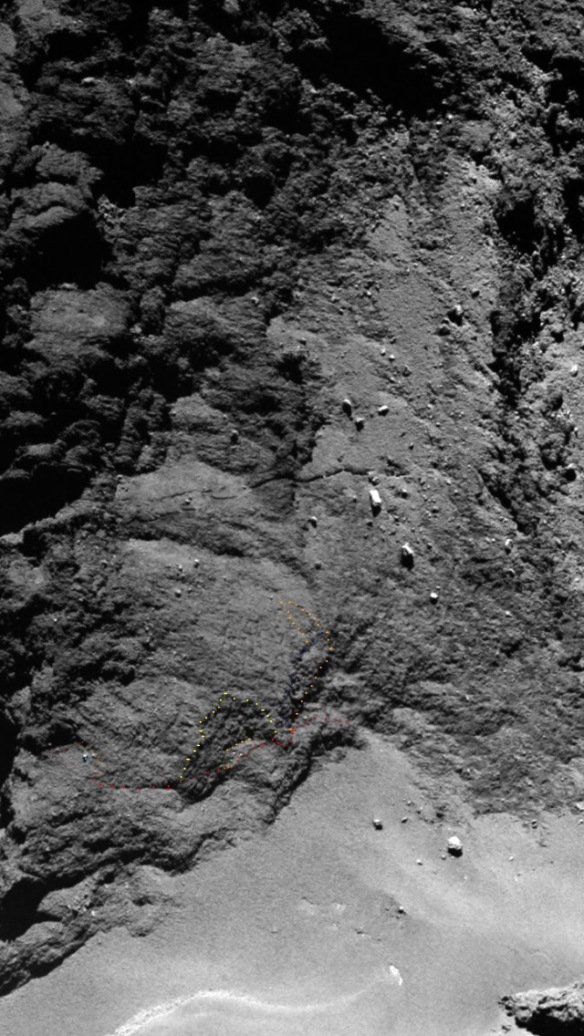

Copyright: ESA/Rosetta/MPS for OSIRIS Team MPS/UPD/LAM/IAA/SSO/INTA/UPM/DASP/IDA/A.COOPER
The ‘yellow’ overhang is crucial because the crack traces a line that is contiguous with its squared-off tip. The tip is therefore an important fiduciary point in both photos. Either side (north and south) of the squared-off tip, the crack departs from the overhang profile so it’s really just skimming past (while skirting round) the squared-off section. It may actually just run under the squared-off tip but since that’s out of sight, the crack is annotated here as going round it.
North of the squared-off tip, the crack runs down one side of a flatter, rectangular area (with two annotated pink dots at one end in the headers plus orange round the back and a bright green, thinner, northern extension). This rectangle is ‘horizontal’ with respect to the ‘vertical’ alcove (yellow) that it passes under. After that, the crack runs along the northern bottom section of the alcove profile, rounds a bend, and continues in a straight line to its end point. The end is where the crack just starts to curve into a small bay with a boulder in it. The bay is annotated brown and the boulder is light blue.
Incidentally, two possible tracks have been annotated for the crack’s track for the short distance between the rectangle and bend. They appear as two alternative red-dotted tracks in different photos in this post. One is an actual crack, the other, another overhang with a bulbous profile. One is above the other (in upright duck mode) so we can’t tell from the top-down, post-perihelion viewpoint in figure 1B, which it is. But I suspect it’s the overhang.
South of the squared-off tip (towards frame bottom in the header; to the right in the photo above) the crack tracks down the sloping massif to a small cove in the cliff base (slate blue). The massif itself slopes up from the cove by enough to reach the overhang’s squared-off tip at its northern end. The squared-off tip also droops a bit to make up the gap and achieve the physical connection.
Thus, the squared-off tip of the overhang is an important fiduciary point for locating the crack in both of the figure 1B photos. It is indeed present in both photos. From there, the same crack can be traced in both photos using additional fiduciary points (slate blue cove, rectangle etc as annotated in the photos above). Since it’s the same crack, it’s not new. And just to make it absolutely clear, here is a reminder of the pre-perihelion photo dated 26th November 2014 showing the same crack.
Photo 6 (reproduced)- the pre-perihelion, 26th November 2014 side view of the crack, showing that it couldn’t have appeared over perihelion 2015 and therefore isn’t new. 
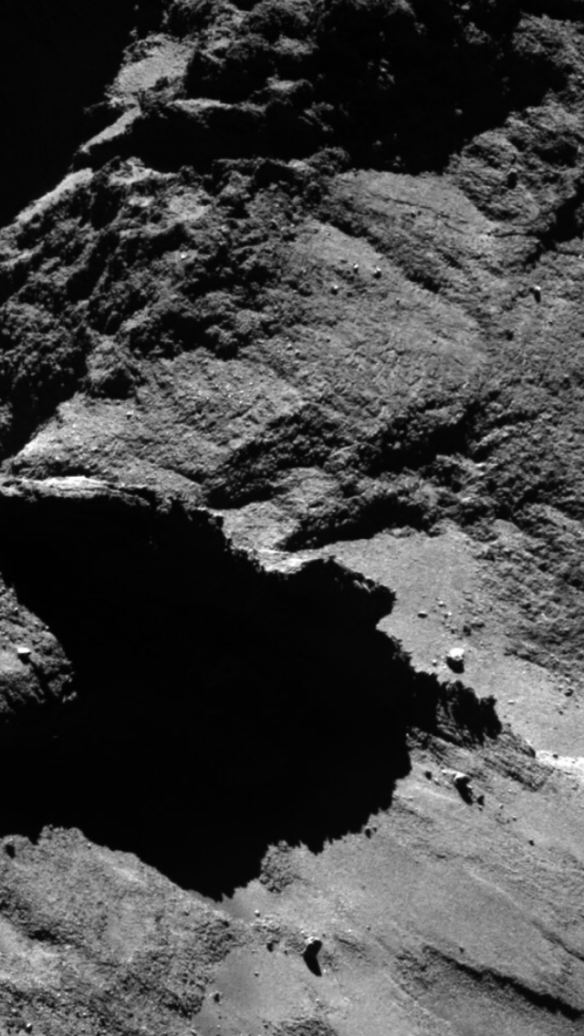
Copyright: ESA/Rosetta/MPS for OSIRIS Team MPS/UPD/LAM/IAA/SSO/INTA/UPM/DASP/IDA/A.COOPER
THE MAIN CRACK BECOMES MORE PARALLEL TO THE SUPPOSED NEW CRACK
Despite the abundance of evidence above, one might be forgiven for wondering how it is that there’s an angle between the supposed new crack and the main crack in the pre-perihelion photo and yet they become parallel in the post-perihelion photo. This is simply one of the vicissitudes of changing perspective by swinging closer to the neck and drifting north.
The important thing to remember here is that the cliff base that kisses the Hapi dust also swings round so as to become parallel to the main crack. The cliff base is essentially parallel to the supposed new crack and the two together swing round to become parallel with the main crack, post-perihelion, after having been at an angle to it pre-perihelion. Therefore, if one argues that the crack can’t swing round that far between the two photos and that it must therefore be a new crack, they also have to explain how the cliff rim can clearly swing round by this degree whilst the crack is not permitted to do so.
The fiduciary points in the header show the pre-perihelion and post-perihelion cracks to be the same anyway. This therefore shows that the swing-round to make the main crack more parallel is a perspective issue. This subsection is somewhat redundant but it’s included for completeness in case anyone is scratching their head over the parallel nature of the cracks in the post-perihelion photo. I have several annotated photos to illustrate the point if anyone wishes me to insert them below here.
THE SUPPOSED MAIN-CRACK EXTENSION
A further extension of the main crack, which is above the supposed new crack, was also cited in figure 1B. We’ve established above that the supposed new crack isn’t new. Other supposed changes on the neck as presented in the paper look dubious to me as well, such as this extension of the main crack. Some of the extra extent is visible in pre-perihelion photos though perhaps not the whole extent. Are the authors scanning this area in all available pre-perihelion photos like Marco does or just looking at this one photo that whites out some of the crack extent pre-perihelion? I fear it’s the latter:
Photo 11- 16th December 2014.
Copyright: ESA/Rosetta/MPS for OSIRIS Team MPS/UPD/LAM/IAA/SSO/INTA/UPM/DASP/IDA/A.COOPER
The red arrow in photo 10 is pointing at precisely the same point as the yellow arrow is pointing to in the pre-perihelion photo in figure 1B of the paper. The yellow arrow is pointing to the supposed lack of a crack extension while the red arrow is pointing to just such an ‘extension’ except it was always there. The reason it’s not apparent in the figure 1B pre-perihelion photo is that a) that photo is somewhat whited out and b) we’re looking down the neck and the ever-present crack is hidden by a small lump.
As I say, there probably is some main-crack evolution in this area but the figure 1B photos don’t support it. Marco had already found a noticeable subsidence episode within the main crack and only metres from the supposed extension area. This would suggest that what had always been visible as a crack extension a bit further along has widened slightly but not recently opened up from nothing.
I didn’t have to trawl the photos to find the crack section marked by the red arrow. I simply know the neck well enough to know this obvious section of the crack was there in 2014. I was constantly drawn to it for two-and-a-half years as the potential smoking gun for spidery crack lines either side of it (which were indeed there, pre-perihelion as well but are beyond the scope of this post). OSIRIS didn’t know about this. They didn’t double-check their figure 1B assertion using photos from all angles and earlier dates and for this reason their approach is severely wanting.
WHY IS THIS IMPORTANT?
If there are no changes on the neck, there will be no supporting evidence for papers such a Hirabayashi et al. 2016 who postulated the tearing apart of the lobes at sub 6.5-hr rotation rates (calculated as sub 5.8 hrs on this blog in 2015- see ‘Spin-Up Calcs’ in the menu bar). If there are spurious changes cited such as a new crack opening up (right on the equator, no less) then spurious support is given to the Hirabayashi paper and all the stretch evidence published on this and Marco’s blog for a year before that.
Even as you read this there will be more papers being prepared which will be looking for such evidence as new cracks or extended cracks. They will need this evidence to support their case for tensile strain due to 67P’s spin-up. This will be in pursuit of a logical evolution from the premises laid out in Hirabayashi et al. (2016) and Movshivitz et al. (2017). Those two papers are slowly inching their way towards the inevitable conclusion that a single body stretched into an ellipsoid then sheared into two separate lobes, essentially describing the title of this blog.
The tensile strain would be actual movement of boulders/surface features and cracks opening, all of them along the equator line vector. Also, papers dwelling on any manner of crack-related phenomena such as outbursts would find such supposed evidence of a new crack useful to cite. Their citations of what is a spurious new crack in M. R. El-Maarry et al. (2017) will compound the problem and subsequent citations of those papers will spread it further like a virus. Cometary science will suffer as a result.
But of course, there really are substantial changes on the neck and they have been quantified in a detailed and professional manner by Marco Parigi. Those four changes- two moving boulders, one cliff collapse and a mid-crack subsidence episode- are the changes that support Hirabayashi et al. (2016) and stretch theory. All four support the idea of a variation in tensile stress acting along the equator line vector as one would expect with the increased rotation rate which occurred in 2015. They provide the tensile strain evidence which should be attracting attention from the OSIRIS team. As long as OSIRIS approach the photo analysis in the manner they have thus far, they’ll miss them.
Moving boulder:
https://www.google.it/amp/s/scute1133site.wordpress.com/2016/08/18/part-55-marco-parigis-moving-boulder-close-analysis-proves-hes-right/amp/
Second moving boulder:
http://marcoparigi.blogspot.co.uk/2016/06/lateral-movement-of-surface-in-anuket.html?m=0
Cliff collapse (including planetary.org article):
http://www.planetary.org/blogs/guest-blogs/2017/20170227-citizen-scientists-spot-rosetta-comet-changes.html
http://marcoparigi.blogspot.co.uk/2016/06/more-on-rockfall-area.html?m=0
http://marcoparigi.blogspot.co.uk/2016/06/rockfall-in-anuket-sah-region.html?m=0
http://marcoparigi.blogspot.co.uk/2016/10/timing-for-anuket-sah-collapse-not.html?m=0
Crack subsidence (including a photo presumably annotated by M. R. El-Marry et al. (2017) which overlooks this impressive change in favour of much less impressive changes to the left):
http://marcoparigi.blogspot.co.uk/search/label/Stretch?m=0
Photo 12- Photo released on the same day as M. R. El-Maarry et al. 2017 so it was presumably annotated by them and used by them for research, although it’s not in the paper. It shows Marco’s obvious crack subsidence event (added red arrow).
Copyright: ESA/Rosetta/MPS for OSIRIS Team MPS/UPD/LAM/IAA/SSO/INTA/UPM/DASP/IDA/M. R. El-Maarry et al. (2017)/ A.COOPER
Photo 12, bottom panel, shows the supposed new crack along with a suggested extension (arrows). The above arguments for the crack apply to the extension too as there’s a faint line here, pre-perihelion, too.
A WORD ABOUT STRETCH THEORY
Stretch theory is now so far advanced that all the evidence for this post was researched and blogged two years ago. I’m looking at these OSIRIS papers as they come out, immediately seeing problems based on a deep prior knowledge of the areas involved and digging out old data to prove my case. I’m not trawling through NAC photos in a reactionary operation to see if I can find fault. True, the NAC photos weren’t available two years ago, only NAVCAM photos were, but the NAC photos were sought out based on that prior knowledge of the area.
The NAC photos used in this post fully corroborate the claims in what are now very old posts. This is the 50th post since that time, every one of them tweeted to @ESA_Rosetta, @RosettaOSIRIS or #67P. This, as well as linking many blog parts on the Rosetta blog comments or emailing the link direct to OSIRIS lead authors.
The early claims have now been built on to the point where we have vastly more knowledge of this particular area around the crack than what is laid out above. We know why the crack is there and why the yellow-dotted alcove above it is there. We’ve worked out why the ‘orange’ line is less well-defined than the green, yellow and mauve lines in Part 25. We know why all four lines have a kink at the same point, halfway up the neck and why yellow and mauve merge below that point. We know the reason for the small coves along the neck base and the patterns in the Hapi dust beyond them. We understand why the overhang and massif are parallel. We know how this relates to the ripples nearby, the spidery outcrop in Hapi nearby and the strange curves leading from it. We know why there’s a straighter line dividing the curves from the ripples, why there’s a Y-shape in the middle of that line and why it ends precisely at the massif tip. We’ve found the reason for the existence and shapes of polygon fields in the Hapi dust. We understand what the lines going up the neck are and where they’ve come from, what the big zig-zag lump is off to the right, where it used to sit and why it would likely be the site of a cliff collapse (which it was). We know how the zig-zag lump relates to the supposed scarps in Sobek further round the neck. We know why the ‘slate blue’ cove sits along an uncannily straight line when viewed from further away. We know why icy blocks are sticking out of Anuket just round the corner from here and why there’s a large protrusion in the Anuket neck high up but directly above the crack. We understand these twenty-four things and much more, based on observation of the morphology at the 5- to 10-metre scale. They are all interdependent, and satisfy only one internally consistent narrative: stretch. The crack, which was there when Rosetta arrived, is just one very small and familiar piece of this jigsaw.
All this work over the last two years leads to the conclusion that this comet is so much more surprising and interesting than we could ever have dared or hoped to imagine.
CONCLUSION
The supposed new crack in M. R. El-Maarry et al. (2017) has been shown to have existed long before perihelion 2015. It’s therefore not new, as claimed in that paper.
OSIRIS simply don’t scrutinise 67P at the same level of detail and resolution as this blog or Marco Parigi’s blog do. Is it any wonder they don’t see the evidence for 67P stretching? Evidence which we have found all over the comet and have been communicating to them, incessantly and via every imaginable medium, for the last two-and-a-half years.


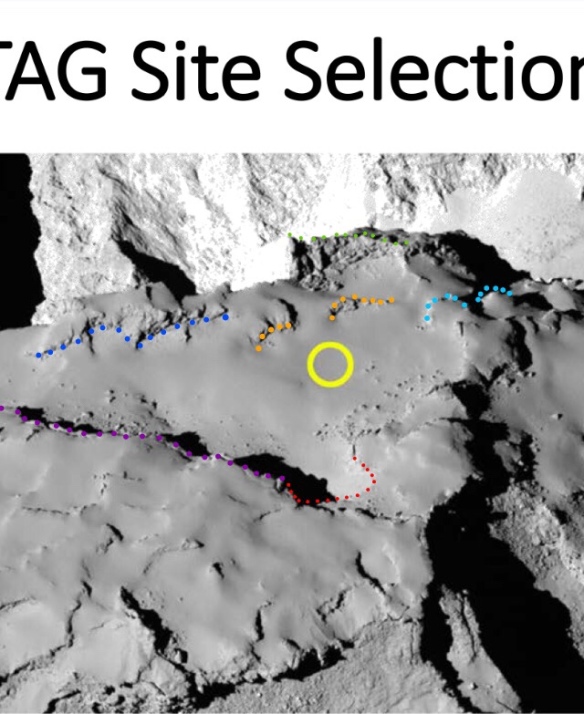


 The mirror-flipped CAESAR photo shows the landing site biased towards the right of a smooth area of the comet. This area has a characteristic shape defined by an obvious perimeter line of cliffs. As with all the smooth areas on 67P, it is (or should be) highly recognisable to scientists working on the comet. One should be able to see at a glance that the photo is flipped and correct it.
The mirror-flipped CAESAR photo shows the landing site biased towards the right of a smooth area of the comet. This area has a characteristic shape defined by an obvious perimeter line of cliffs. As with all the smooth areas on 67P, it is (or should be) highly recognisable to scientists working on the comet. One should be able to see at a glance that the photo is flipped and correct it.

 Top Photo: ESA/Rosetta/MPS for OSIRIS Team MPS/UPD/LAM/IAA/SSO/INTA/UPM/DASP/IDA/CEASAR
Top Photo: ESA/Rosetta/MPS for OSIRIS Team MPS/UPD/LAM/IAA/SSO/INTA/UPM/DASP/IDA/CEASAR


